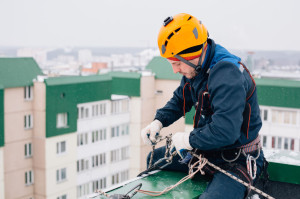 Construction projects don’t stop just because winter comes every year. But winter does pose special challenges for construction crews. This means that construction managers and administrators need to prepare and take special steps to ensure safety on the construction site. Some of the special challenges include:
Construction projects don’t stop just because winter comes every year. But winter does pose special challenges for construction crews. This means that construction managers and administrators need to prepare and take special steps to ensure safety on the construction site. Some of the special challenges include:
- increased risks of slips and falls on ice, snow and wet surfaces
- stress from cold
- frostbite
- injuries from snow removal machines
- reduced mobility because of thicker cold-weather clothing
- falls from heights
- reduced light during shorter winter days
Prepare the ground
Before allowing any construction work to start, managers and supervisors need to remove snow and ice from the worksite. Even after shoveling snow, surfaces can still be covered with a thin layer of slippery ice. Use ice-melting compounds that do not degrade the construction materials (salt can be highly corrosive to concrete, steel and iron).
Without the stabilizing effect of grass and other plants during the warmer months, soil can become unstable and dangerous for workers. To help stabilize soil that’s not covered by grass, add mulch. Netting or erosion-control blankets can help hold soil in place.
Site managers need to pay special attention to doorways, staircases, walkways and ramps, and ensure they are always clear of snow and ice.
Secure excavation holes by putting up barricades or surround them with berms to prevent workers from falling in.
Prepare the people
Construction managers need to ensure that extra precautions are in place, and regularly monitor that safe procedures are being followed by everyone on the crew.
Proper personal protective clothing and equipment is always essential for safety on a construction site. In winter and cold temperatures, this gets more challenging.
Ensure all workers are wearing clothing suitable to the conditions, including non-slip boots. Risks of falling on ice make hardhats even more important.
Workers in cold temperatures should wear layers of clothing. The innermost should be made of wicking material, to pull sweat away and to prevent chills. The outermost layers should be waterproof. If their clothes get wet, workers need to change into dry clothes to stay warm.
Ensure that workers have minimized the amount of skin exposed to the cold. Knit hats that cover the ears, wool socks, balaclavas and mittens are best, as long as they can do their work with mitts on.
Watch workers for tell-tale signs of cold stress such as hypothermia, frostbite or trench foot. Symptoms of these can include unusual clumsiness, slurred speech, numbness in extremities, grayish skin, weakness, and tingling sensations.
If you assign snow shoveling to the construction workers, be aware that this work can be very strenuous, especially for those who do not do regular cardiovascular exercise. Every year in the United States, some 11,000 people suffer snow shoveling-related health problems, from injuries to cardiac issues. Make sure that anyone you assign to these duties is physically able to do so without injury.
Construction administrators and supervisors also need to provide more frequent breaks for workers outdoors, so they can go into a heated area regularly. Inspect portable heaters frequently, and ensure heated areas are properly vented. Install working carbon monoxide sensors to monitor for exposure.
Prepare the site
Lighting is critical, especially at the darkest times of the year when the daylight hours are short, from November to mid-February. Ensure that the most-used areas of the construction site have sufficient lighting. LED lighting is the most energy efficient and most resilient to cold temperatures.
Adapt operating procedures
Winter makes driving and operating heavy machinery more challenging. Make certain that all equipment drivers are trained in winter driving techniques such as negotiating icy, slippery ground and maintaining vehicles for cold weather operation. Ensure that vehicles and sites are stocked with emergency items, such as jumper cables, blankets, flashlights, flares, water and non-perishable food.
Cold temperatures, ice and snow add stress to construction materials, as well. In these conditions, operations such as masonry work, pouring concrete, drywall finishing and painting can take longer, or just become impossible.
For example, concrete cannot be allowed to freeze for the first 24 hours after being poured or placed if it’s going to achieve its necessary strength. Sheeting concrete can ensure required conditions if the weather is not severe, but in extremely cold situations, construction managers need to consider heating systems or enclosures for fresh concrete.
Similarly, mortar mix must be kept from freezing after brick-laying during the winter months.
Low temperatures and humidity play havoc with drying of drywall compound. It could take several days in low temperatures for it to dry enough to be painted. And low temperatures also make paint behave differently. Consider installing heaters, or waiting until the weather gets better for these steps.
Watch the weather forecast
Blizzards and heavy storms can make work sites even more hazardous, and any progress in construction impossible. When you know that bad weather is approaching, give the construction crew enough time to secure the site and get to safety before the wind and snow start blowing.
Construction administration is crucial
Safety on the work site is crucial to successful projects. At McNeil Engineering, we focus on ensuring safety on the worksite throughout the year so that you, the customer, can be assured of a structure that meets its goals, schedule and budget. And more — that it exceeds your expectations.
Take a look at our track record of construction administration, and call us to find out how we can help bring your next project in on time and on budget.








